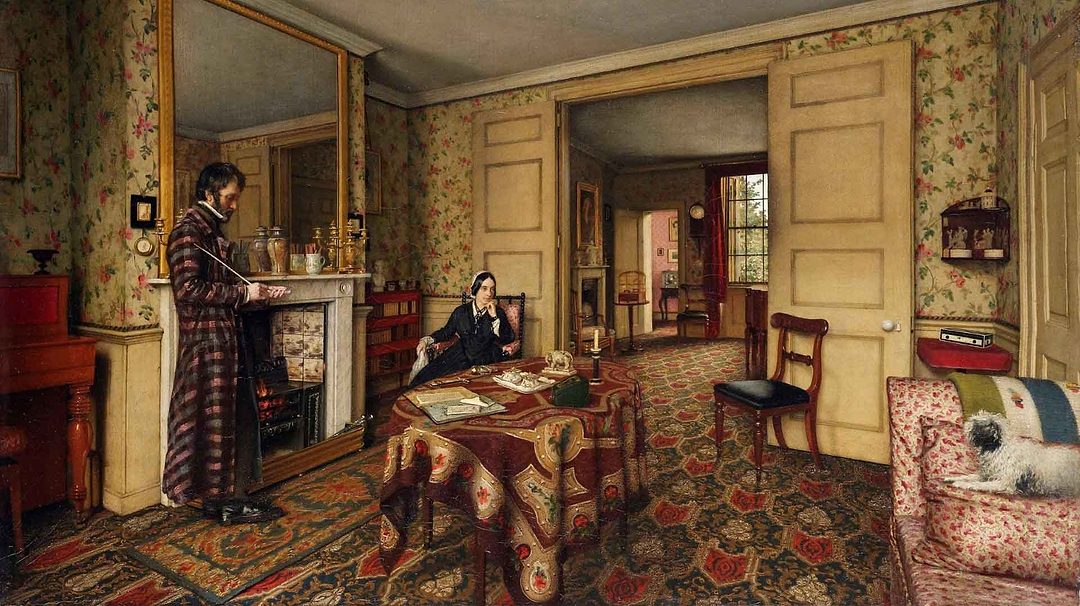Of all the writers and philosophers who influenced the New England Transcendentalists, none had a bigger impact than Thomas Carlyle. Born in Scotland in 1795, as an essayist, historian, and philosopher, Carlyle had a profound influence on the 19th century, not just in the United Kingdom, but also in America, particularly with the writers in Concord, Massachusetts.
Virtually every member of the Transcendentalist circle read Carlyle’s writings with great enthusiasm; Bronson Alcott, Orestes Brownson, Theodore Parker, William Henry Channing, Ralph Waldo Emerson, Margaret Fuller, Frederic Henry Hedge, George Ripley, and Henry Thoreau all drew inspiration from Carlyle. In particular, it was his writings on Germanic literature that lit a flame under the Transcendentalists. He was the main channel through which Göethe, Kant, Schiller, and Hegle flowed into Concord.

Daguerreotype of Thomas Carlyle, sent to Emerson in April 1846
Like the writings of the Transcendentalists, much of Carlyle’s work was concerned with the human spiritual condition; he was the first writer to use the expression “meaning of life,” and in Sartor Resartus (1831), Carlyle developed a philosophy of religion based on what he called “Natural Supernaturalism,” the idea that all of nature can reveal divinity and that existence itself is miraculous, filled with elements that cannot be defined by science. It should be no surprise that Carlyle, much like his hero Göethe, and the Transcendentalists after him, was accused by many for being pantheistic and blasphemous.
From the very first time that he read Carlyle in 1827, Emerson was enamored, calling his works “by far the most original and profound essays of the day.” He saw in the Scotsman a kindred spirit and they would meet in 1833 when Emerson, grieving the death of his first wife and traveling through Europe, went to Scotland. They spent 24 hours together, “talking thro’ the whole encyclopedia.” Both Carlyle and his wife Jane commented that seeing Emerson was like a visit from “an angel,” that he’d made their day “look like enchantment.” It was the beginning of a life-long friendship.

Carlyle’s study
| ©Richard Smith. Used with the permission of the National TrustThey would meet face to face only a few more times, in 1847, 1872, and 1873, when Waldo was in the United Kingdom, but their correspondence would go on for 40 years; there were 173 letters in all between them. It’s obvious from their letters that they genuinely admired one another. Carlyle called Emerson “Brother,” writing that, because of Waldo, “New England is as much my country as Old England” (although he never visited America). In return, Emerson called Carlyle the “Truth-Speaker” and the “best Thinker of the Saxon race.”
In the 1830s, Emerson became a key player in getting Carlyle’s books distributed in America. He personally arranged for the publication of Sartor Resartus (1836), The French Revolution (1837), and the Critical and Miscellaneous Essays (1838–39) by James Munroe & Company and Little & Brown of Boston. These editions brought Carlyle a wider audience, while earning him £655 in much-needed royalties.
As the years went by, the friendship of Emerson and Carlyle would gradually cool. By the 1840s Carlyle was not as “transcendental” as he seemed the previous decade, and he saw Emerson’s writings as “mystical” and “airy.” Also, Carlyle was growing more conservative in his politics, and his writings revealed deeply held racist views; in his book Occasional Discourse on the Negro Question (1849), he openly opposed the abolition of slavery, while at the same time Emerson was speaking out more and more in favor of abolition. Their correspondence would continue well into the 1870s, and while they disagreed on much, there was still a genuine warmth and affection between them.

Photo of Emerson in the Carlyle House
| ©Richard Smith. Used with the permission of the National TrustLike Emerson, other members of the Transcendental circle made their pilgrimage to Chelsea. Bronson Alcott visited in 1842, with Emerson introducing him to Carlyle as “a great man.” Carlyle found Alcott “a genial, innocent, simple-hearted man, of much natural intelligence and goodness, with an air of rusticity, veracity, and dignity…all bent on saving the world by a return to acorns and the golden age.” He thought Alcott’s vegetarianism odd, but he informed Emerson that they got on well: “Let him love me as he can, and live on vegetables in peace, and I living partly on vegetables will continue to love him!”
Margaret Fuller visited England in the spring of 1846, and Emerson looked forward to Carlyle meeting “this wise, sincere, accomplished, and most entertaining of women.” Both Carlyle and his wife Jane were impressed with Fuller. He later wrote to Emerson that he had found her a “high-soaring, clear, enthusiastic soul.” To his brother John he was more honest, commenting that Fuller was “a strange, lilting, lean old maid, not nearly such a bore as I had expected.”
The story is often told in conversation (and it may be apocryphal) that Margaret supposedly told Carlyle, “I accept the universe,” implying that the universe was to feel complimented by her declaration. Posterity (if not the historical record) noted Carlye’s reply, “By Gad, she’d better!”
As a historian, Carlyle wrote on his “Great Man” theory, contending that history is shaped by exceptional individuals. He gave six lectures on the subject in 1840, all of which were published in his book On Heroes, Heroes Worship, and the Heroic in History in 1841. These lectures caught the eye of Henry Thoreau, and while he never met or corresponded with Carlyle, he was a devoted reader of Carlyle’s works. While living at Walden Pond he wrote a lecture called “The Writings and Styles of Thomas Carlyle,” which he delivered at the Concord Lyceum in February 1846. It’s obvious he was impressed:
“Such a style — so diversified and variegated! It is like a New England landscape, with farmhouses and villages, and cultivated spots, and belts of forests and blueberry swamps…with the fragrance of shad-blossoms and violets on certain winds. And as for the reading of it…it is like traveling, sometimes on foot, sometimes in a gig tandem; sometimes in a full coach, over highways, mended and unmended…[But] you have got an expert driver this time, who has driven ten thousand miles, and was never known to upset; can drive six in hand on the edge of a precipice...”
Thoreau’s lecture would be serialized into two parts and published as “Thomas Carlyle and His Works” in the March and April 1847 issues of Graham’s Monthly Magazine.
Today, you can visit the home in Chelsea, London, where Carlyle met his Transcendental admirers. Walking into the home one can imagine not only the presence of Carlyle and his wife Jane, but also that of the Concord “gossips” (as Emerson described them to Carlyle) in the same rooms; the parlor where Emerson and Carlyle discussed literature and philosophy; the dining room where Alcott surprised the Carlyles with his vegetarian diet; the sitting room where Margaret Fuller charmed her hosts. Theodore Parker visited here, too. As did Thomas Wentworth Higginson. The home has been restored to the way it looked when they were all there.
The walls of the house are filled with images of Carlyle’s heroes. Göethe is there, of course, and Frederick the Great. But there are also pictures of Carlyle’s friends. Walking up the stairs to the second floor you’ll recognize a familiar face, and another photo of that same man hangs in Carlyle’s third floor study: smiling back from the walls of a 300-year-old Georgian townhouse, some 3,300 miles from Concord, is Ralph Waldo Emerson.
There are two portraits of Carlyle in Emerson’s home as well, both hanging in the dining room. A print of a young Carlyle was sent by Carlyle himself, and when Waldo framed it, he cut Carlyle’s name from some correspondence and placed it on the print. A second image, taken in 1867, shows an older but still powerful-looking Carlyle.
And so, the Sage of Concord and the Sage of Chelsea stay forever connected. Carlyle wrote “the history of the world is but the biography of great men,” while Emerson echoed this sentiment with, “All history is biography.” Separately and together, their lives and writings influenced not only each other and their generation but generations far beyond the 19th century.
Richard would like to thank the staff of the Carlyle House in London for giving him a wonderful tour of the house in May 2024. To visit the Carlyle House online or in person: NationalTrust.org.uk/visit/london/carlyles-house


